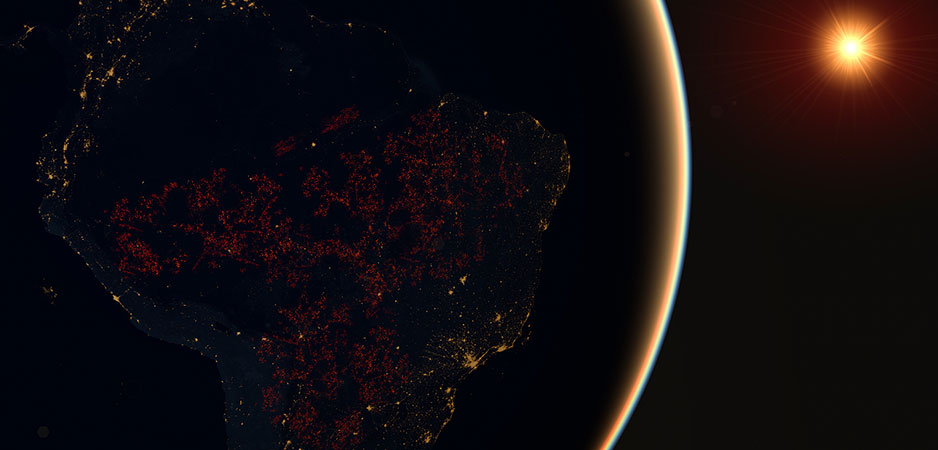The Amazon is burning. This is what the end of the world looks like. Oh, and there’ll be more forests burn, more forests felled by chainsaws, more wetlands drained, more rivers dammed, more grasslands plowed, oceans further toxified and emptied of fish.
And each of these is what the end of the world looks like.
The end of the world looks like factory trawlers pulling in net after net full to bursting with fish — the fish’s eyes popping out from the pressure of all those bodies squeezed together. It looks like puffins starving to death. It looks like emaciated polar bears. It looks like whales washing up on shore and walruses not finding ice on which to rest.
The end of the world looks like plows digging into grasslands, turning over soil and killing all who live there, even down to bacteria. It looks like rows of monocrops, as far as the eye can see.
The end of the world looks like humans staring at screens, clucking their tongues at the destruction of forests far away, never noticing that they themselves — whether they’re in London, New York, Paris, Rome, Athens, Beirut, Beijing or Baghdad — are standing in clear-cuts.
The end of the world looks like cities, with most of their residents never giving a thought to who and what was killed to build that city, never giving a thought to who and what was killed to mine, manufacture and move everything they consider necessary to their lives, and never thinking about what is necessary to life and what is not.
The end of the world looks like humans turning the planet to human use. Or rather attempting to, because it’s not possible to turn this wild and fecund Earth totally to human use, and this attempting is itself what is causing the end of the world.
From the beginning of this culture, it has been so. When you think of Iraq, is the first thing you think of cedar forests so thick that sunlight never touches the ground? That’s what it was like, prior to the beginning of this culture. The first written myth of Western civilization is Gilgamesh deforesting the hills and valleys of Iraq to make a great city.
Have you heard of Mesopotamian elephants? Most of us haven’t. They were exterminated to make way for this culture. And when you think of the Arabian Peninsula, do you think of oak savannas? These forests were cut for export to fuel the economy, to build cities.
The Near East was heavily forested. We’ve all heard of the cedars of Lebanon. They still have one on their flag. The great forests of North Africa were felled to make the Phoenician and Egyptian navies. Greece was heavily forested. So was Italy. So was France. The great forests of Britain came down to make the navy that allowed the sun never to set on the British Empire.
This is what this culture does. Forests precede us and deserts dog our heels.
The end of the world was not written into human existence. For most of our species’ time on Earth, we’ve lived sustainably. The Tolowa Indians lived where I live now for at least 12,500 years, and when the dominant culture arrived, salmon still ran so thick they turned entire rivers “black and roiling” with their bodies. There was no such thing as “ancient redwood forests.” There was only “home” — a home filled with trees thousands of years old, a home filled with nonhumans in abundance most of us literally cannot conceptualize.
Can you imagine — and this moves us across the continent — flocks of passenger pigeons so large they darken the sky for days at a time, flying 60 miles per hour and sounding like rolling thunder? Can you imagine so many whales that the air looks foggy, just from their breath? Can you imagine fish in such abundance that they slow the passage of ships? Can you imagine entire islands so full of great auks that one European explorer said they could load every ship in France and it would not make a dent? Well, they did, and it did, and the last great auk was killed in the 19th century.
How did the world get to be so full of life in the first place? By each creature making the world richer by living and dying. Salmon make forests stronger by their lives and deaths. Redwood trees do the same. Buffalo make grasslands stronger by their lives and deaths. Wolves do the same. And humans can do the same. But not living the way we do.
The Tolowa were not alone in their sustainability. There have been sustainable cultures the world over. The San of southern Africa, for example, evolved in place. They have lived there, in human terms, forever.
And how have humans lived sustainably in place? Simple. By not destroying the places where they lived, and by not destroying other places either. By improving the habitat on its own terms by their presence. The Tolowa made land-use decisions, just as all other beings on the land do, and just as we make land-use decisions. But the Tolowa made these land-use decisions on the assumption they would be living in a place for the next 500 years. That assumption changes everything about how you make decisions and how you live. It is the difference between life and death, between sustainability and the end of the world.
The end of the world was not written into human existence. It was, however, written into the story of Gilgamesh. The end of the world is written into this way of life of converting the Earth solely to human use. It was written into existence with the plow, and with the cities the plow makes possible.
The logic is simple and inescapable. If you convert the land that previously grew bushes and trees that fed elephants into wheat that feeds humans, you can grow more humans per hectare. Many of these humans can become a standing army. And you can use those trees you cut down to build ships of war. You now have a competitive military advantage over those who live sustainably, over those who do not destroy their land base. Further, because you’ve degraded your own land base, you must expand into other land bases. But fortunately for you, you’ve got a standing military.
This is the last 6,000 years of history. This is the story of the end of the world.
More than 90% of forests on the planet have been destroyed. The same is true for wetlands, grasslands, seagrass beds, large schools of fish, wildlife populations in general.
This culture is killing the planet. It doesn’t have to be this way. Not every culture has lived this way. Not every culture has killed the planet.
Recently, more and more people are talking about the possibility of human extinction. That possibility has entered our consciousness enough that, in December 2018, The New York Times published an op-ed asking whether it would be better for the Earth if humans went extinct.
As the Amazon burns, here’s the thing that haunts me. How is it that this culture can contemplate the end of the Amazon rainforest, contemplate the end of elephants, great apes, insects, fish in the oceans? How is it that it can blithely destroy life on Earth? How is it that it can with not much horror contemplate human extinction, but cannot contemplate stopping this way of life?
If aliens came from outer space and did to Earth what this culture is doing — change the climate; burn the Amazon; deforest the planet; vacuum the oceans and put dioxin in every mother’s breastmilk; and bathe the world in plastics, endocrine disrupters and neurotoxin — we would know exactly what to do. We would resist. We would fight as though our lives depend on it. We would destroy the aliens’ infrastructure that allows them to wage war on the planet that is our only home.
Or, put another way, if the Amazon could take on human manifestation, what would it do? If salmon could take on human manifestation, how long would dams stand? If humans from the future could come to our time, how would they act?
As the writer Lierre Keith often says, “If there are any humans left 100 years from now, they are going to ask what the fuck was wrong with us that we didn’t fight like hell when the world was going down.”
Many of us who know history might have fantasies of how we would have acted were we alive under German occupation in World War II or under British colonial rule. Right now, we are facing the end of the world. We have the opportunity and the honor to protect the planet that gave us our lives.
The time is now. Roll up your sleeves and get to work. Life on this planet needs you.
The views expressed in this article are the author’s own and do not necessarily reflect Fair Observer’s editorial policy.
Support Fair Observer
We rely on your support for our independence, diversity and quality.
For more than 10 years, Fair Observer has been free, fair and independent. No billionaire owns us, no advertisers control us. We are a reader-supported nonprofit. Unlike many other publications, we keep our content free for readers regardless of where they live or whether they can afford to pay. We have no paywalls and no ads.
In the post-truth era of fake news, echo chambers and filter bubbles, we publish a plurality of perspectives from around the world. Anyone can publish with us, but everyone goes through a rigorous editorial process. So, you get fact-checked, well-reasoned content instead of noise.
We publish 2,500+ voices from 90+ countries. We also conduct education and training programs
on subjects ranging from digital media and journalism to writing and critical thinking. This
doesn’t come cheap. Servers, editors, trainers and web developers cost
money.
Please consider supporting us on a regular basis as a recurring donor or a
sustaining member.
Will you support FO’s journalism?
We rely on your support for our independence, diversity and quality.





